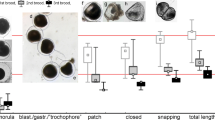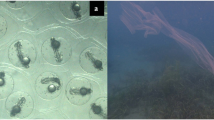Abstract
Ephippia ofCeriodaphnia pulchella Sars were collected at 2 sites from successive sediment layers.
Hatching observed in the laboratory gave information about the duration of their viability. Conclusions about the hatching situation in the lake were drawn from the ratio of intact to total ephippia at various lake depths. The results are discussed.
Similar content being viewed by others
References
Herzig, A., 1985. Resting eggs — a significant stage in the life cycle of the crustaceans:Leptodora kindti andBythotrephes longimanus. Verh. int. Ver. Limnol. 22: 3088–3098.
Kajak, Z., 1971. Benthos of standing water. In W. T. Edmondson (ed.), Secondary productivity in freshwaters, IBP-Handbook 17: 25–65. Blackwell Scientific Publications, Oford & Edingburgh, 358 pp.
Kankaala, P., 1983. Resting eggs, seasonal dynamics and productivity ofBosmina longispina maritima (P. E. Müller) (Cladocera) in the northern Baltic proper. J. Plankton Res. 5: 53–69.
Löffler, H., 1958. Schlüpfbedingungen beiDaphnia-Ephippien. Wasser und Abwasser 1958: 3–7.
Mellors, W. K., 1975. Selective predation of ephippialDaphnia and the resistance of ephippial eggs to digestion. Ecology 56: 974–980.
Ogi, K., T. Asai & H. Nakai, 1951. Factors influencing the start of development inDaphnia pulex winter eggs. Ecol. Rev., Sendai 13: 24–26.
Pancella, J. R. & R. G. Stross, 1963. Light induced hatching ofDaphnia resting eggs. Chesapeake Sci. 4: 135–140.
Pechlaner, R., 1968. Beschleunigte Eutrophierung im Piburger See, Tirol. Ber. naturw.-med. Ver. Innsbruck 56: 143–161.
Pechlaner, R., 1971. Die Restaurierung des Piburger Sees. Carinthia 2, Sonderheft (Festschrift Findenegg) 31: 97–115.
Pechlaner, R., 1979. Response of the eutrophied Piburger See to reduced internal loading and removal of monimolimnic water. Arch. Hydrobiol. Beih. Limnol. 13: 293–305.
Pehofer, H. E., 1977a. Bestand und Produktion benthischer Nematoden im Piburger See (Ötztal, Tirol). Diss. Abt. Limnol. Innsbruck 7: 1–87.
Pehofer, H. E., 1977b. Ökosystemstudie Piburger See. Datenzusammenstellung bezüglich Temperatur, Sauerstoffgehalt, el. Leitfähigkeit, pH, Alkalinität, Ca-und Mg-Gehalt. Jber. Abt. Limnol. Innsbruck 4: 24–31.
Proctor, V. W., 1964. Viability of crustacean eggs recovered from ducks. Ecology 45: 656–658.
Psenner, R., 1978. Ökosystemstudie Piburger See. Datenzusammenstellung bezüglich Temperatur, Sichttiefe und Chemismus des Piburger Sees im Jahr 1978. Eisbedeckung und maximale Eisdicken der Jahre 1966–1978. Jber. Abt. Limnol. Innsbruck 5: 34–46.
Psenner, R., 1983. Die Entstehung von Pyrit in rezenten Sedimenten des Piburger Sees (Tirol, Austria). Schweiz. Z. Hydrol. 45: 219–232.
Schlott, G., 1976. Die Chironomiden des Piburger Sees (Ötztal, Tirol). Diss. Abt. Limnol. Innsbruck 4: 1–77.
Scourfield, D. J., 1902. The ephippia of the lynceid Entomostraca. J. Quekett microsc. Club 8: 217–244.
Shan, R. K., 1970. Influence of light on hatching resting eggs of chydorids (Cladocera). Int. Revue ges. Hydrobiol. 55: 295–302.
Stross, R. G. & J. C. Hill, 1965. Diapause induction inDaphnia requires two stimuli. Science 150: 1462–1464.
Stross, R. G., 1966. Light and temperature requirements for diapause development and release inDaphnia. Ecology 47: 368–374.
Thaler, B., 1977. Die benthischen Crustaceen des Piburger Sees (Ötztal, Tirol). Diss. Abt. Limnol. Innsbruck 8: 1–177.
Weismann, A., 1879. Beiträge zur Naturgeschichte der Daphnoiden. 4. Die Entwicklungsstadien der Dauereier. Z. wiss. Zool. 33: 55–270.
Wood, T. R., 1932. Resting eggs that fail to rest. Am. Nat. 66: 277–281.
Wood, T. R. & A. M. Banta, 1937. Hatchability ofDaphnia andMoina eggs without drying. Int. Revue ges. Hydrobiol. Hydrogr. 35: 229–242.
Author information
Authors and Affiliations
Rights and permissions
About this article
Cite this article
Moritz, C. A note on the hatching and viability ofCeriodaphnia ephippia collected from lake sediment. Hydrobiologia 145, 309–314 (1987). https://doi.org/10.1007/BF02530292
Issue Date:
DOI: https://doi.org/10.1007/BF02530292




